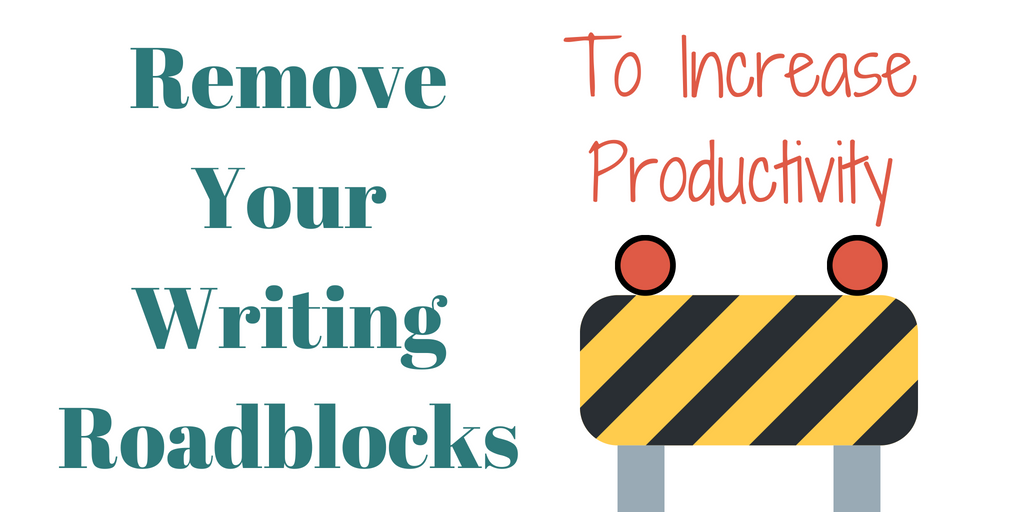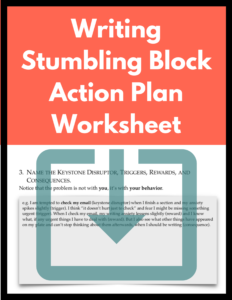I’m a big fan of setting goals to help make scholarly writing less daunting. I’ve encouraged you to set product-focused weekly goals and set goals for and track your individual writing sessions. But my hope is to help you write more, with less effort.
To do that, it’s also important to track not just how your products are shaping up, but also how your writing process is going. Doing so will help you identify your own writing roadblocks, and then take steps to reduce their impact. Remember that scholarly writing is a marathon, not a sprint. So, these small, incremental changes will quickly compound, helping you write more with less effort over time.
This post is the second in a two-part series. In the first part, I walked you through identifying your unique writing challenges. In this post, I’ll guide you through the process of removing one of these challenges over the course of three weeks. The initial preparation work (steps 3-7 below) should take you about one hour; monitoring your progress should take only a few minutes each week.
Ready to begin to write less effortlessly?
Bonus: Want a downloadable version you can print and fill out as many times as you’d like? Click the image below!
Or, want to see this plan in action? Check out my post on how to tackle one common roadblock: a persistent inner editor that barrages you with critical or frustrated thoughts and demands you perfect your writing as you go.
Step 3: Pick Your Keystone Disruptor and Identify Possible Triggers
For the next 3 weeks, you will focus on eliminating the behavior with the biggest negative impact on your writing routine: I’ll call this the “keystone disruptor,” to echo Charles Duhigg’s formulation of the “keystone habit.” There are two main ways to define “negative impact”: you can choose the behavior you do the most frequently, or you can choose the behavior that derails you the most.
Once you’ve chosen your “keystone disruptor,” identify common triggers. According to Duhigg, there are five main triggers for behavior: time, location, preceding action, emotional state, and other people. Sometimes behaviors are triggered by a combination of two or more triggers, so keep all of these in mind as you’re looking for commonalities. Maybe, for instance, you want to eliminate the “keystone disruptor” of persistent critical thoughts, which you think are triggered by an emotional state of anxiety. But then, upon further exploration, you discover that these thoughts are primarily triggered when you begin a new section of writing (preceding action) and happen more frequently in the afternoon (time).
Step 4: Remember Why and Envision Writing Without this Disruptor
You’ve identified a routine you run automatically and subconsciously. I’m not going to lie to you. Replacing or eliminating these routines takes conscious work. It might be simple, but it’s anything but easy. So, to keep you motivated, it helps to have a concrete vision of why you are doing this in the first place.
To foreground your own motivation, return to the paragraph you wrote last week about your ideal writing session.
This week, focus in specifically on the piece of your writing routine that has to do with your keystone disruptor. Write 2-3 sentences, using as much detail as possible, describing what your writing session will look like without that particular disruptor. Using emotional language will help you connect more deeply here.
Keep both the paragraph you wrote last week and the one you just wrote where you plan to do your writing. I recommend you read them before you start each day.
Step 5: Brainstorm How to Remove Triggers
As Duhigg shows, habits are tricky because they are automatic routines we run subconsciously in response to a trigger. So, there are two main ways to eliminate a bad habit. First, you can eliminate the trigger. Ask yourself: what ways can I imagine removing the trigger?
Additionally, it is always a good idea to add steps to make undesired behaviors harder to do, and remove steps to make desired behaviors easier to do. For instance, if you struggle with checking your phone during writing sessions, consider turning it completely off, leaving it out of the room you’re in, or turning it on “Do not Disturb” or “airplane” modes. Any of these will require you to do two things (turn on your phone, then open it) instead of just one (open it).
Similarly, if you’re trying to cultivate the habit of writing first thing in the morning, you can engineer your environment the night before to remove any obstacles you would potentially face in the morning. So, you could: make sure your document and goal tracking spreadsheet are the only windows open on your computer and your computer is on your desk (or by the door, if you plan to leave the house). Assemble all necessary books, notes, and writing utensils. Set your coffee maker to brew before you get up. Prepare your breakfast and lay out your clothes (if you will be leaving). In so doing, you’ve eliminated several steps which previously served as critical moments for your brain to say “no–I don’t want to!”
Step 6: Develop Replacement Routines
The second way to eliminate bad habits is to develop a replacement routine that gives you the same reward, but does not include the “bad” habit. For instance, I regularly find myself visiting a few websites when I get bored or crave social interaction. After discovering the real reward driving this behavior, any time I feel the “urge” to check these websites, I now text or call a friend instead. This, of course, is not necessarily the answer during writing time, but it illustrates my larger point.
Think about the reward your undesired behavior gets you: is it temporary relief from your emotional state? The quieting of critical voices?
Once you begin to identify the reward you associate with your routine, you can brainstorm replacement routines that will get you the same reward. Imagine yourself doing these behaviors when you feel the “urge” to do your current keystone disruptor. Can you see yourself really doing them? If not, continue brainstorming until you have identified at least one realistic replacement routine.
Step 7: Pre-Mortem and If-Then Plans
Replacing or eliminating habits takes conscious effort. Paradoxically, even though it’s hard in the long term, people often experience stunning initial success. But then something happens. Right when you think you’ve broken your old habit, and your new routine is permanent, you backslide. And then, discouraged by this return to the routine, you give up. Unfortunately, backsliding is normal. But it doesn’t have to mean you give up. A little bit of effort before you begin
First, conduct a pre-mortem. Take out a piece of paper, and set a timer for 3 minutes. Now, respond to the following prompt:
It’s a month later. Your new habit has failed, and you’ve returned to your old ways. There’s no doubt about it. It was a total and utter failure. Why and how did this happen?
This exercise is shockingly effective to help you identify all of the possible ways your plan can fail. Once you have an idea of how your plan can go sideways, you can take preventative measures before this happens.
Using the pre-mortem, identify possible obstacles in your plan. For instance, maybe your plan is to write every morning with a colleague in a local coffee shop. But one morning your colleague texts that she’s sick. So, you tell yourself that you will write at home, but find yourself catching up on email instead. Now, imagine how you could have prevented this from happening, using an “if-then” statement. “If she bails, then I will still go to the coffee shop.” Planning ahead of time means that if this situation arises, all you have to do is follow the script you already laid out, saving you precious willpower.
Step 8: Test and Track for 2-3 Weeks
As mentioned above, you will have hiccups and backslides. Know that this is a normal part of the process, and that persisting will pay off.
But sometimes it’s also in trying trigger removal and replacement routines that we discover additional layers of the original behavior. Perhaps you thought you would be able to prep everything the night before, but then you discovered in practice this doesn’t completely solve the issue. Or perhaps you thought your trigger was only a “preceding event”–every time you finished a section of your paper you checked social media–but then you discovered that you only did this when you were in your office.
So, test your trigger removal and behavior replacement and track how it’s going.
If it’s a complete failure in the first week, know that it might get easier. If it has not gotten easier after two weeks, move on to step 9.
On the other hand, if it seems like an immediate and impressive change, you should track for a minimum of 3 weeks. Most people who make significant changes experience an initial wave of enthusiasm that makes the new “way of life” seem deceptively easy. But when this enthusiasm wanes, they backslide and give up quickly. Your goal–if this is your experience–is to get through this backslide period, to test-run your “if-then” plans, and to discover new potential pitfalls that you can address in the next step.
Step 9: Recalibrate and Repeat
Whether your plan was complete or very limited success, congratulations on making it this far! Now, you should have an idea of additional stumbling blocks you face in replacing your existing keystone distractor. Redo abbreviated versions of steps 5-7 above before re-testing your plan for at least 3 weeks. By the end of this second run, your new plan should be working fairly well for you. If you feel there are still things you need to tweak, re-do steps 5-7 as many times as needed. Or, if you feel comfortable with your new routine, you can return to the list you developed while monitoring, and choose your next keystone disruptor to eliminate.


Leave a Reply